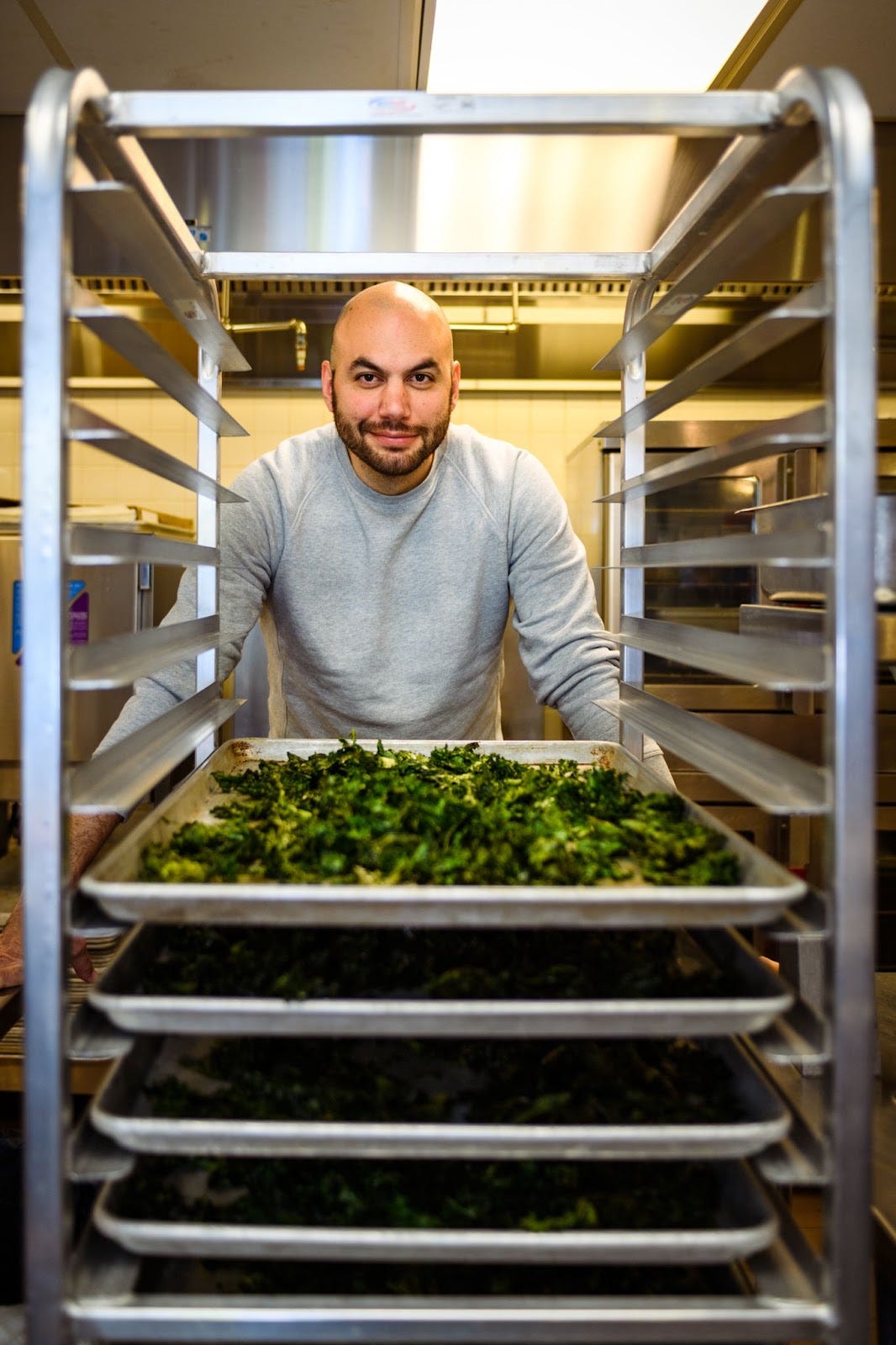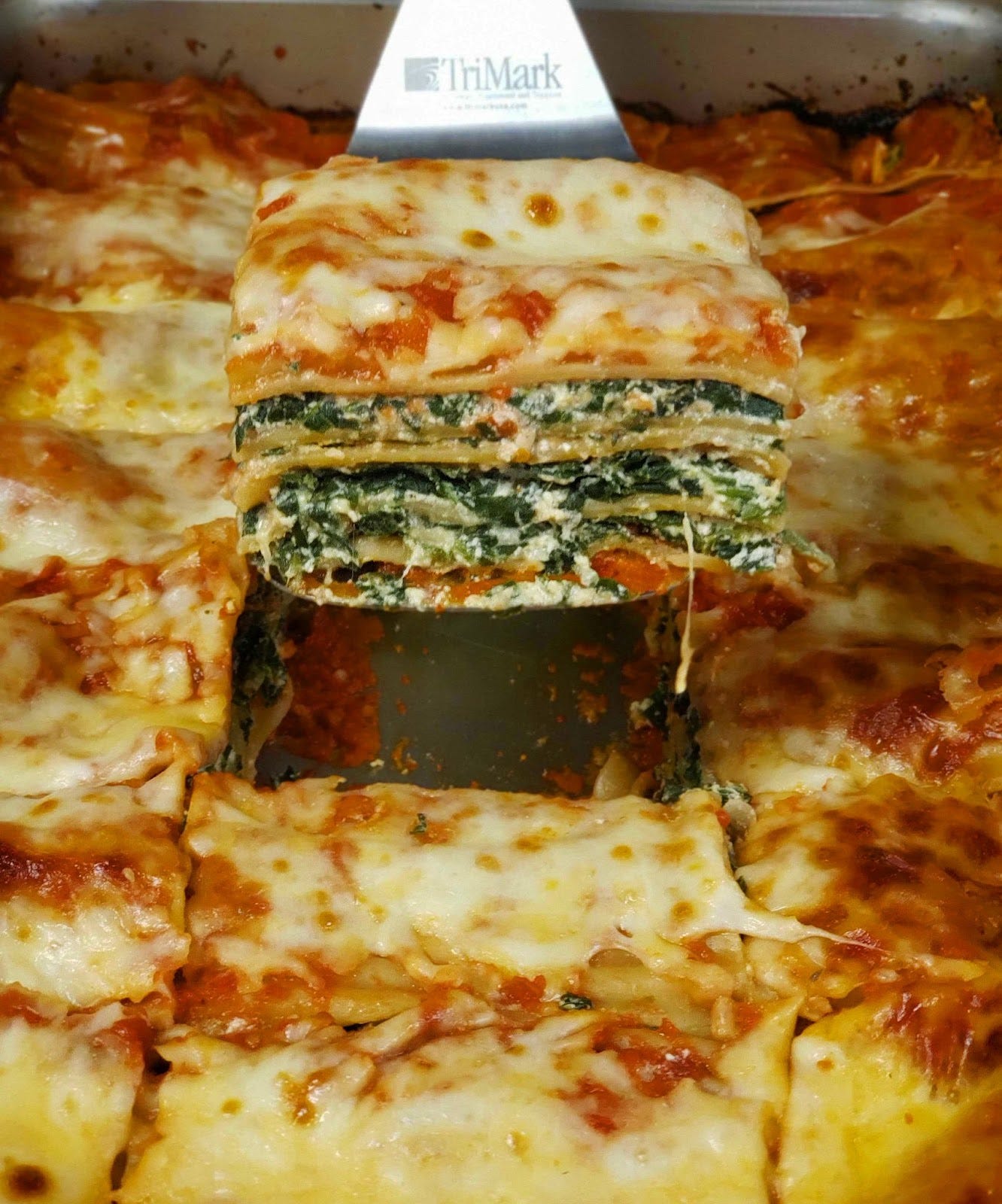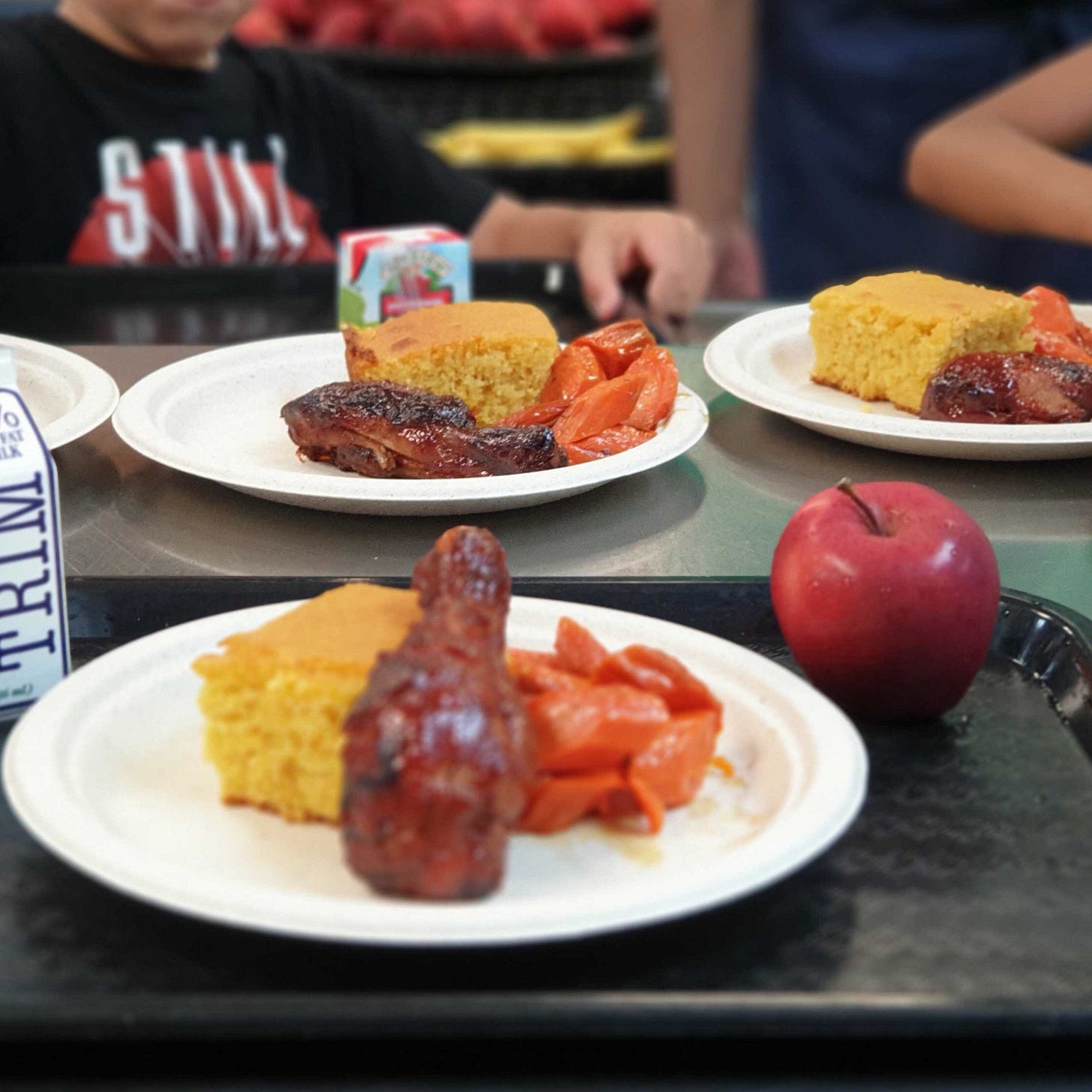Dan Giusti wants to transform institutional food.
Meet Brigaid's Dan Giusti, who is bringing chefs into school cafeterias, and using the power of food to address childhood hunger and diet-related disease.
Amigos,
I really cannot believe it is September already…but it’s back to school time, which means that school food is on top of my mind.
In this country we have two huge problems that face our children: hunger and diet-related disease. For one of the wealthiest countries in the world, both of these problems are fixable, and one way to tackle both is with changes to school food programs!
You know, millions of children across the country rely on school lunch for their daily nutrition. For these kids who live at or under the poverty line, school breakfast and lunch are their only meals of the day. But food insecurity is not the only problem facing our country’s children: obesity, diabetes, and high blood pressure are also hurting our kids, particularly children in low-income families…the kids who rely on school meals the most.
So you see…it’s all connected…the kids who are food insecure and need the school meals most are also those who suffer from diet-related disease. What if there was a way we could solve both issues? As I have said before, it often seems like food is the problem, but actually it’s the solution.
Right now, the USDA has nutrition standards for school meals, but our system of nutrition does not put value on homemade or scratch-cooked food; it relies on manufactured foods, taken from a bag or a big box and popped in an oven to feed our children. It seems to me when you put such little care and thought into millions of meals that are supposed to fuel the minds and bodies of our children, you are missing a huge opportunity for good. What if we had cafeterias filled with home-cooked meals made by hands-on cooks, who are using local and seasonal ingredients to cook but also could cook recipes from cultures all around the world that might appeal to the diversity of families in our communities.
I am excited to tell you that on September 28th the White House will be hosting its Conference on Food and Nutrition, where we will call upon our legislators and policy leaders to end hunger, improve nutrition, and reduce diet-related disease. I will be fighting to create a cabinet position in the White House: a Secretary of Food, not just a Secretary of Agriculture, because food touches on everything—equality, obesity, social justice, immigration, climate change, even national security. But I will share more on that in a couple of weeks, closer to the date of the Conference.
For now, I want to introduce you to someone who is doing great work for school lunches, the chef Dan Giusti, who I got to know when he was a guest lecturer for my course World on a Plate at George Washington University, where I cover the connections between food, agriculture, labor, national security, nutrition, and more.
Dan, who is the former head chef of Noma, is the founder of Brigaid, an organization he created in 2016. His mission is to make sure that every child, not just those fortunate enough to have parents who have the time and money to make lunch at home, can have healthy, delicious, and exciting food from school.
Through Brigaid, Dan is not only improving the quality of school food, he’s also inspiring the next generation of chefs to consider working in school food or “institutional” food settings instead of at restaurants. He’s one of my favorite food fighters and I thought you might like to get to know more about his work.
We talked with Dan about his goals for school food, how to check your ego in the cafeteria, the power of cooking for children, and what is ahead in 2023.
Dan, how did you get inspired to work in school food?
I worked in fine dining for my entire career but I got to the point where I felt I’d gone as far as I was going to go. I was head chef at Noma, and that gave me the confidence to think more about why I got into cooking in the first place. And I realized it had nothing to do with fine dining; it was about enjoying cooking and feeding my family and making people happy through food, and cooking for them often. Not just once a year or once a month. When you cook for people often, like you do for your family, you have so much impact on who is eating that food because they are eating it all the time. I wanted to make an impact and I started to think about how to do that.
How did you get to school food from that idea of making an impact?
I read an article about school food in 2015. I knew a little about school food because of the work of Michelle Obama, but this article sparked an interest in institutional food. It checked all the boxes for me: I could feed people who need it, feed people every day, and I wouldn’t be producing more food or creating food waste, I would be taking over a segment of food that’s already being served and trying to make it better. I also liked the idea of supporting food service workers who might not be getting the best training to do their jobs. School food allowed me to do all of these things.
Your first Brigaid School District was in Connecticut. How did that end up happening?
Once word got out about Brigaid, I started having lunch with anyone who reached out to me and wanted to improve school food, from local moms to school principals. One of the meetings I took was with the superintendent of New London Public Schools, a district where 1 in 4 people live under the poverty line. I knew I wanted to start it there. That was the beginning of everything. In January I got home from Noma, and by March 2016 we had the contract approved and started to look for chefs.
How does Brigaid work?
In a nutshell we are brought on by a school district and together we hire a chef or chefs (depending on the size of the district) and work together to reach the district’s goals. We don’t come in and say this is what you have to do. Rather, they look to us for advice and expertise. We try to answer questions like, What is the best thing we can produce for kids together? We look at what they have in terms of infrastructure, training levels, and what they are serving now? How much is scratch cooking? We take all that and our chef works with them to make a plan. We do menu and recipe development, staffing plans, and chef training. Folks in the kitchen are rarely set up for success and that’s a big part of what we do. We meet them where they are. We train their food service workers and we work together to do the best food we can do.
There’s often this tension in school food circles that we can’t change the food to make it healthier, because kids won’t eat it and they will go hungry. And we can’t have that. How do you handle that?
When we started I had a set idea of what food should be, but that was naive. I was a little pretentious. Because kids don’t want to eat what I want to cook; and the most important thing is that we have to feed the kids food that they will eat; hunger is a huge issue. And let me be clear: you cannot prioritize health over hunger. You have to get kids fed, that's the most important thing. I’ve heard people say they’d rather have their kids not eat at all than eat sugary cereal. If you say that then you’ve never had to think about where your child’s next meal is coming from. So I always prioritize hunger over nutrition. That’s not to say we don’t want to address both, we do, and we are, but if a kid won't eat anything unless it’s a chicken nugget, then we make that available to them, and we work towards giving them other options and help them start to like other foods that are better for them.
Your kids are eating barbecue chicken on the bone, vegetable lasagna and kale! So much kale! How did that happen?
It takes time to develop trust with students. You can't change the food overnight, because the kids won't eat it. Six years into our time in New London, all of the food is made from scratch, and we are serving a lot more veggies and the kids not only eat them all, they really enjoy them. The school has become a shining star within their town and people believe in what we are doing. Also now that we are six years in, the first graders have never even seen a chicken nugget in their schools – they have only seen roasted chicken on the bone. And they love it. That’s amazing to see.
How do you build trust with kids and get them to try your scratch-made recipes?
We do tastings with the kids to get them more excited about new recipes. This is especially important for those kids who are dependent on school meals. The idea of eating something that you’ve never tried before as your main meal that is meant to carry you through the next day, we can’t do that. So we offer tastings of new dishes a week in advance on days when we are serving things that are familiar.
Our chefs make their way into the cafeteria and very informally chat with the kids and build rapport, dialogue, and relationships and they try to get kids to articulate why they did or did not like something. You have to understand why they think something is gross and try to help them find the words to why they didn't like it. There is no substitute for that casual talk. That’s how kids will feel comfortable and build trust. And we go back and make changes based on that feedback. That goes such a long way because the kids feel part of the process.
Tell us about the menus that you’ve created for the kids.
There’s a lot that I love but one of the recent dishes was created by Lei Lovendino, who is the Lead Cook at Jennings Elementary in New London Public Schools. She developed an amazing Adobo Chicken with Rice for us. It’s a recipe she has been making her whole life for her own children, and we made the recipe school lunch compliant (so it matches the USDA nutrition standards), and now it’s in the rotation. There’s so much meaning to that dish and the kids love it. There are also simple things like Kale Chips that we’ve been doing since day one, that kids can’t get enough of. In Denver one of our chefs developed a recipe for sorbet that’s made from half frozen strawberries and half thawed out strawberries, and when you put it in the Hobart, it turns into sorbet in a second with nothing added. It’s delicious, we were blown away. And now we do it in New London too and the kids are loving it.
We serve homemade focaccia once a week with pasta, and that’s such a simple thing but when you make it from scratch, it’s so much better for you. And warm home baked goods like bread or a muffin, it smells good and the kids feel that comfort. The staff likes that they are baking something that their kids are loving.
There’s a White House Conference on Nutrition and Health coming up at the end of September. What are some of the big picture food policy changes you’d like to see?
Universal free meals for the entire country is the way to go. It’s happening in more and more states but it’s crucial to make it nationwide. I’d love to see more states giving extra reimbursement to school districts that buy local. New York does that and it makes it easier to use local foods. We need incentives to support school districts that want to do more scratch cooking. They need the capital to buy new equipment and to support staff training. I’d also love to see more discussion about raising pay rates for school food workers. These are staff who have dedicated their lives to these kids and the only way you can make food better is if you can take care of your staff. You can't have people leave to go to Walmart. So that needs to be a discussion otherwise you can have all the equipment and local food in the world but if you can't retain staff the food will never get better.
Brigaid has expanded quite a bit; you’re now in school districts in Buffalo, Denver, Oakland, Monterey, Sacramento, and San Ramon, and in the DC Phillips Program. Looking ahead say 10 years, what is your big picture goal?
I’m thrilled by how much we have grown. I guess if I had to say one goal it would be to transform institutional food service so that it’s seen as a viable, exciting, and worthwhile career path for well-trained ambitious chefs.
How do you measure success?
It’s difficult to measure success in this space because as I’ve said, it takes a long time to see results. A lot of our success is anecdotal, whether its students changing eating habits and enjoying the school food, or staff members feeling that they are getting paid more, or working in a supportive environment where they are more appreciated by the kids. If we are able to hire chefs who are motivated to do this work and we can improve the quality of the food students are eating, and the relationships are positive between chefs and food service workers and the school district, then that is a success. It won't happen overnight, it will take years, but it will happen.









How does someone go about introducing their local school district to Brigaid?
I live in New London and admire Dan's work. The team works with USDA restrictions and a miniscule food budget (something like $2 for a healthy lunch, less for a breakfast). Yet they've come up with great menus that the kids will eat.
The staff used to microwave packaged stuff, but now they're real cooks, in real kitchens.
Pre-Covid, they had monthly meals for the community, so we could taste what the kids were getting, and it was terrific.
So glad the word is spreading.
New London provides a free lunch for every child, no income restrictions.